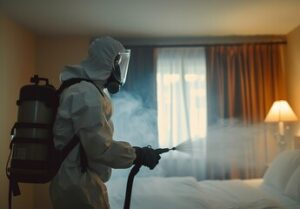The goal of IPM is to control pests using the least harmful methods possible. This includes avoiding pesticides whenever possible.

Monitoring means checking your field, garden, crop, or structure regularly for pests. This can include scouting and trapping. It also can involve assessing damage and looking for signs of natural enemies. Click https://facilitypestcontrol.com/ to learn more.
Taking a preventive approach to pest control is the best way to stop infestations before they start. It’s a lot easier to keep pests out than it is to get rid of them once they have made themselves at home inside your house or on your farm.
Clutter is a major draw for many pests, and regular cleaning can help banish it. Sweeping, vacuuming and wiping down all surfaces can remove food crumbs, spills and residue that can attract pests. Washing dishes and clothing on a regular basis can also eliminate the odors that can encourage pests to move in. For example, a simple solution of vinegar and water can deodorize sinks and clean drains that can harbor flies or other pests.
It’s important to check for and block any entry points that pests could use to enter the home, too. Make sure all doors seal tightly and that windows don’t have holes that pests can slip through. Check all screens and replace those that are damaged. Seal all cracks around the house and check every cable, plumbing and heating passage through walls to ensure they are properly screened.
Another important part of preventive pest control is to introduce natural enemies into the environment where a problem exists. In the garden, this means using predators to control insect populations or introducing parasitoids that feed on the pests and help keep their numbers low (Longe, 2016). In the barn or stable, this can mean adding in some beneficial insects to prey on the unwanted ones.
In the field, preventing pests from damaging crops starts with extensive monitoring to keep tabs on specific pest populations over time. This enables the farmer to see how a pest is spreading and will alert them when their population has reached the point of economic injury. It will also allow them to select the best management options based on the economic threshold and other environmental and cropping factors.
In the yard, it’s also important to maintain a tidy landscape and not let debris or plant materials sit too close to the house. Wood piles should be kept away from the foundation and all brush, tree limbs and shrubs should be trimmed back so they are not touching the roof or siding. This can keep rodents, birds and other pests from using them as highways directly into the house.
Suppression
Pests are a nuisance, they damage homes and crops, and they pose risks to human health. While they may be harmful to humans and animals, the good news is that we can learn to live with pests and manage their numbers. Pest control methods vary widely depending on the type of pest and its habitat. Some methods include chemical, biological, and cultural. The goal of pest management is to minimize the damage caused by pests while maintaining a balanced ecosystem.
The first step in integrated pest management (IPM) is to collect information about pests and their impact on plants, people, and the environment. The collected information is used to identify and analyze the problem, develop control measures, and monitor the effectiveness of the treatments. This allows farmers to take preventive action and remain one step ahead of their pests.
In addition to collecting data, farmers should consider the biology and ecology of a pest before applying any management techniques. The economic thresholds set by a farm should be taken into account, as well as the sensitivity of beneficial and nontarget organisms to various treatment methods. This approach can reduce the use of pesticides and other chemicals, while maximizing yield and protecting human, animal, and plant health.
Many pest problems are the result of ecological changes. For example, the introduction of new plant varieties and agrotechnical practices like monoculture, selective breeding, and planting in monotypic stands have altered the natural balance of insects and other organisms. In addition, globalization and trade have increased human interaction with other nations and led to the rapid transfer of diseases, insects, weeds, and other pests.
The easiest way to prevent pests is to prevent them from entering the home. To do this, check for rodents and bugs around the house and trim tree branches that hang over or touch a home, as these act as ladders for pests. Additionally, make sure to have all entry points sealed such as gaps and cracks in the attic, chimney, soffits, roofline, and any other openings. If a pest infestation does occur, contact Divided Sky for help.
Eradication
Pest control from an eradication perspective focuses on purposefully controlling pest populations to a desired level, such as zero. Attempting to eradicate all pests at once, however, is nearly impossible and historically has led to problems such as pesticide resistance and environmental contamination (Longe, 2016).
A variety of techniques are used in this approach, including biological, genetic, and physical controls. Biological controls often reduce or eliminate the need for chemical insecticides. Some examples include parasitoids and natural enemies that kill, slow reproduction, or debilitate the target pest. These biological control methods are also less likely to cause off-target effects, and they may take several days or more to be effective against the pest (Longe, 2016).
Genetic controls involve modifying the target organism through breeding programs, gene silencing, or molecular manipulations. Modifications such as RNA interference can prevent the expression of certain proteins that lead to target organism phenotypes, or the production of chemicals called phytoalexins.

